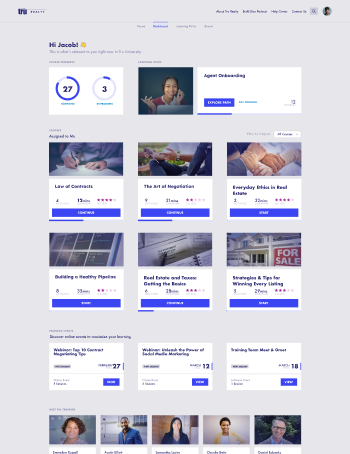
Custom LMS 101
A custom LMS gives you the flexibility to completely tailor the learning experience exactly how you want for your customers, employees, partners or workforce.
A custom LMS gives you the flexibility to completely tailor the learning experience exactly how you want for your customers, employees, partners or workforce.
Customer, employee and partner education is a big part of your success.
It improves retention and reduces churn.
It boosts product and feature adoption.
It levels up engagement and other mission-critical metrics.
Basically, education is a key driver of business success today, which is why more learning teams are building their programs on the backs of learning management systems (LMS).
But not just any LMSs — custom LMSs that give them complete control to tailor their academies in any way they want.
Here's everything you need to know about a custom learning management system.
A custom LMS or custom learning management system makes it possible to completely personalize your academy without having to develop your own software from scratch. Conversely, traditional LMSs often restrict what you can do in terms of the design, usually limiting you to changing logos and colors.
While there's nothing wrong with that, traditional LMSs lack the flexibility you need to create an academy that acts as a seamless extension to other brand touchpoints, including your website.
Northpass is the only 100% custom LMS that gives you total control over how your academy looks and feels to your customers, employees or partners.
With Northpass, you can customize everything from the branding, typography and layout to the course cards, buttons and more, allowing you the unrivaled ability to create a seamless and frictionless experience for your learners.
Scroll through a few examples below of what your academy could look like with Northpass.









One of the biggest benefits of a custom LMS is how simple they are to get off the ground.
Once you’ve chosen an LMS vendor, here are some of the steps you can expect while you build up to launch:
The first step that needs to happen before you start customizing your LMS is an analysis of what you and your learners need.
During the analysis stage, you should examine your reasons for designing a custom LMS, including what your goals are for your program and what you need to customize and what would be a "nice-to-have."
You should also consider factors like the budget. While custom LMSs, like Northpass, allow people with little technical chops to get the job done, there may be another layer of customization that'd require more support. If that's the case, additional fees may apply.
Next, you can start using the custom LMS to develop and launch your academy.
This is the part when you can exercise your creative control to create a learning environment that not only reflects your brand but also offers the kind of learning experience you’re seeking to provide.
You can personalize the look of your LMS, the way users navigate through courses and learning paths, and of course, the content itself.
After you’ve finished customizing your academy for launch — you can always go back and iterate — you may need to transfer over any existing learning data.
This could include previously-designed courses you want to reuse in your new academy or any other relevant data from your previous LMS or tech stack.
At this point, your custom LMS is still not quite ready to launch yet, but you're getting close.
Before launching your custom LMS, you should look to activate any integrations you or your learners may need. For example, if you're taking advantage of a CRM-LMS integration, you'll want to make sure HubSpot or Salesforce are working properly. Similarly, if you're relying on technology like Zapier to automate some tasks, you should make sure it's working as expected.
Remember: Even the most customizable LMSs and academies won't be as effective if the learning experience isn't top-notch.
Before you launch for real, you may want to do a “soft launch.” This is sort of like a quality assurance period during which a small, specifically selected group of people try out the LMS and attempt to simulate all possible scenarios from the learner's point of view.
A soft launch can allow you to test every aspect of the LMS design, from the navigation through courses, modules, and learning paths, to the feel of the user interface, to technical aspects like mobile responsiveness. Engaging in this quality assurance period before you launch can help you catch any last issues and ensure a smooth experience for your customers right out of the gate.
Once you’ve completed quality assurance, it’s time to officially launch. But that doesn’t mean your work is finished. Even after launch, there’s still more you can do to provide ongoing support.
One of the most important ways you can provide this support is by continually sourcing feedback from your learners — without this feedback, you’ll have no way of knowing if your LMS is actually achieving the goals you set out to accomplish.
After you gather feedback, you should review that feedback and then make improvements to your LMS design or your course content as needed. Then, gather even more feedback and make even more improvements. By creating an iterative feedback process, you can continuously improve your academy.
Thank you.